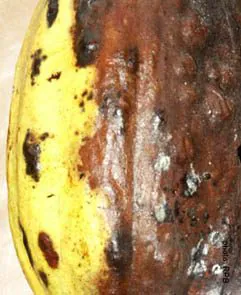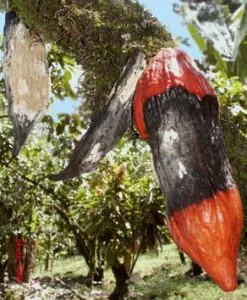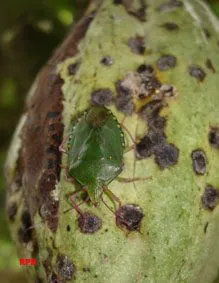
Issues with the Mainstream Cacao Industry
Ever wonder how Hershey’s Kisses, M&M’s, or Snickers bars are made? How about that high class Belgian Chocolate? Well, it’s starts on a production oriented farm… and in many of those instances, it’s not a pretty picture.
Well, it turns out 70% of the global cacao market comes from cacao farms in West Africa [1] and most chocolate producers, particularly those from the top 10 producers like Mars, Mondelez, and Nestlé, are not concerned with ensuring the people growing the chocolate are getting a fair deal. Most cacao farmers, especially in Africa, live below the poverty line and earn less than $2 a day [2]. In some instances conditions amount to slavery and child labor.
The implications of the global cacao industry are, in fact, multifaceted, and in the same way consumer choices reach back into the lives of cacao farmers, the cultivation practices directly impact consumers.
But not all cacao is grown in the same way. Mandala Naturals is one of a growing group of ethically sourced chocolate makers, and we’ll talk about how it’s different as well.
History of Cacao through Modern Child and Slave Labor and Un-Fair Trade
The history of the modern global cacao industry starts late compared to this history of cacao, which has been used since at least 2000 B.C. societies in the Americas.
However, the modern cacao industry was started by Europeans. Cacao was brought to Africa from the Americas for the first time in the 1800’s after a Dutch inventor create the cacao press making it possible to mix cacao with liquids. The first chocolate bars were produced in 1840. Indeed, as early as the late 1800’s governments like the Belgian government took a keen interest in supporting a lucrative cacao trade by regulating cacao products for purity. [3]
Although cacao made it’s way to Africa around the end of legal global slave trades in the earlier part of the 1800’s [4], that does not mean that slavery was not part and parcel. Furthermore, despite the transition from large corporate owned plantations to small farmer owned operations, the legacy of the European slave trade’s impact on Africa continues to this day.
The documentary The Dark Side of Chocolate by Miki Mistrati explores the world of mainstream chocolate and it’s social impacts including how slave trade and child labor are still serious concerns.
Non-Native Growing Environments
That cacao is not native to Africa has a significant impact on its growth. African cacao struggles with a host of fungi, viruses and insects that cacao trees did not evolve alongside including Black Pod Rot, Capsid type insects, Stem boring insects, Swollen Shoot Virus, root diseases, Water Pod Rot and other cacao pod diseases [5].
Although it’s possible to grow cacao sustainably in some non-native environments, the additional non-native stressors challenge the process, which is only exacerbated by monocrop growing strategies. Often, especially in the money oriented global cacao trade driven by top chocolate candy producers, the solution to these challenges is chemical pesticides and fertilizers [6], which are even more necessary in the monocrop plantation model imported by European chocolate producers.
Ecosystem Destruction
Deforestation of native forests has been an impact of cacao in Africa for centuries, and continues.
There are many factors to why forests may be clear-cut for cacao farming, from mono-crop plantation formats, to increasing yield.
Deforestation isn’t just bad for the ecosystem and globe in general, due to factors cacao trees life-cycle, and the impacts of overall forest health, micro-climate change, soil quality and overall farm economics and farmer livelihood, maintaining a more diverse forest ecosystem that mirrors cacao’s native environment is important. [7]
Still, the long term perspective and information needed to fully understand the benefits and methodologies of bio-diverse cacao agro-forestry systems are not prevalent in most global cacao production at this time. Ultimately more programs like Öko-Caribe in South America are needed to be spread. Research and education is even more important in Africa where cacao is actually a non-native plant, and cacao growing traditions are younger and more difficult [7].
Unhealthy Cacao, Unhealthy Chocolate
Bad farming practices and non-native pest issues result in unhealthy cacao plants.
Unhealthy Plants
Cacao has been recognized as a powerful superfood for centuries, but with modern science we can really see how it shines.
However, a plant can only work with what it has. Without rich nutrients in the soil, a plant cannot grow nutrient rich foods! Nutrients come from a diverse and thriving ecosystem, not from chemical fertilizers.
Cacao from mono-crop cacao plantations that lack biodiverse agroforestry practices and employ heavy pesticide and fertilizer won’t have the same nutritive qualities [8,9,10]. But it’s not just for personal health, unhealthy plants are a reflection of an imbalanced ecosystem, environmentally and socially.
Bio-accumulation
Cacao is a powerful bio-accumulator. If grown in locations that have heavy metals or other unhealthy chemical, cacao does an excellent job of absorbing them. [11]
Luckily for the land, when the cacao is then shipped away, so are the toxins. However, if the cacao is then made into chocolate, then the end consumer – you! – will absorb those unhealthy heavy metals into your body!
This isn’t just a possibility, it’s an actual concern! [12]
This is another reason, of many, that well sourced cacao is so important.
Chemical Contamination
Using pesticides on cacao doesn’t just impact the environment, it can also contaminate the cacao.
Cacao is rich in fat (cacao butter), which absorbs the active ingredients in insecticides. Contamination of cacao by insecticides is a real issue that can effect both taste and health [13].
By removing insecticides and other chemicals from the farming and processing environment, it not only supports the general ecosystem but the healthiness of the end product: amazing chocolate.
The Product of Unhealthy Plants in an Unhealthy Environment and a Financial Imperative
Conventional (non-organic, mono-crop) cacao production is a present day extension of European imperialist practices that still maintains the vestiges of slavery and other serious human right violations.
The economics of the top 10 chocolate producers, which are responsible for almost all of the chocolate market are not engaging in fair or responsible cacao trade and exacerbate all of the issues mentioned above.
These challenges are significant, and while you may not consider yourself directly involved in the cacao trade, if you eat chocolate, then in fact, you are!
Your choices matter! Choose ethical – delicious and healthy! – chocolate!
What Makes Mandala Naturals Different?
And there are choices. Mandala Naturals makes not only the most healthy chocolate on earth, we also take great care in sourcing our organic, farmer first chocolate that supports the greater environment.
Organic, Sustainably Grown, Socially Responsible Chocolate
We source our Chocolate from South America, currently from Ecuador in the highlands west of Quito. Our cacao beans currently come from certified organic family farms working with programs like Öko-Caribe , a collaboration with funding from the Ministry of Agriculture and Livestock for the “High Quality Aromatic Cacao Reactivation Program, and NGO programs like the Conservación & Desarrallo (Conservation & Development, C&D) and Maquita Comercio Justo (MCJ) which focus on (C&D) sustainable development and rational use of natural resources through education and awareness, and (MCJ) supporting low-income families, communities and organizations in Ecuador, Domincan Republic and beyond via Social and Solidarity Economics.
You can see farmers from the coops producing cacao speaking (in Spanish) about the positive impacts of the program in this video from Minga del Cacao. The closed captioning with auto-translation might provide an idea of what they are speaking (with many errors) if you do not speak Spanish.

Nurturing the environment where cacao is produced, and leveraging healthy native ecosystems to do so, helps produce not only a rich, healthy living environmental ecosystem, but productive farms with happier, healthier people. Mandala Naturals is proud to be able to support these socially and environmentally responsible and sustainable family farms.
Healthy Ecosystems = Nutritious Cacao
Moreover, the healthier cacao plants, create better tasting and more healthy cacao and thus chocolate, hearkening back to cacao’s “food of the gods” reputation that came from the Maya people.
Made with Care
It’s not just the sourcing of the cacao though – Mandala Chocolates are made with care.
From the carefully created recipes developed over years of research and careful chocolate making, to the long-stone grind that ensure the wonderful nutrients and compounds are as bio-available as possible, and more…. The nuanced process of working with the cacao crystallization process to give excellent tempering, is an art and meditation. We infuse our chocolate with a prayer and intention during this step of the process.



